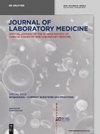Female patients with SLE-associated APS have a lower ovarian reserve than either PAPS or SLE patients
IF 1.8
4区 医学
Q4 MEDICAL LABORATORY TECHNOLOGY
引用次数: 0
Abstract
Objectives To evaluate the ovarian reserve (OR) in women with antiphospholipid syndrome (APS), systemic lupus erythematosus (SLE), especially SLE-associated APS, and to determine the association between OR and clinical and laboratory parameters. Methods We compared the antral follicle count (AFC), anticardiolipin antibody, and anti-Müllerian hormone (AMH), inhibin B (INHB), antiphospholipid (aPL) antibody, follicle-stimulating hormone (FSH), progesterone (P), testosterone (T), and estradiol (E2) among patients with primary APS (PAPS), SLE-APS, and SLE who were treated at Jinhua Central Hospital between 2017 and 2020. We conducted correlations and logistic regression analyses to identify the risk factors of OR failure in women with APS. Results Serum AMH were positively correlated with AFC and INHB in APS patients, and low AMH was independent risk factor for OR decline in APS patients. The ROC curve showed a high accuracy for AMH in the prediction of OR failure. Compared to healthy subjects (HS), patients with PAPS, SLE-APS, and SLE exhibited lower serum AMH, AFC, INHB, and E2 levels and higher FSH and levels (p<0.05). Of all the patients, those with SLE-APS manifested the lowest serum AMH, AFC, INHB, and E2 levels and the highest FSH levels (p<0.05). Conclusions APS and SLE patients showed lower indications of OR, including AFC and AMH, compared to HS. SLE-APS patients also appeared to have a lower OR than either SLE or PAPS patients.与系统性红斑狼疮相关的 APS 女性患者的卵巢储备功能低于 PAPS 或系统性红斑狼疮患者
目的 评估抗磷脂综合征(APS)、系统性红斑狼疮(SLE),尤其是系统性红斑狼疮相关 APS 妇女的卵巢储备功能(OR),并确定卵巢储备功能与临床和实验室参数之间的关联。方法 我们比较了2017年至2020年间在金华市中心医院接受治疗的原发性APS(PAPS)、系统性红斑狼疮-APS和系统性红斑狼疮患者的前卵泡计数(AFC)、抗心磷脂抗体和抗缪勒氏管激素(AMH)、抑制素B(INHB)、抗磷脂抗体(aPL)、卵泡刺激素(FSH)、孕酮(P)、睾酮(T)和雌二醇(E2)。我们进行了相关分析和逻辑回归分析,以确定APS女性患者OR失败的风险因素。结果 血清AMH与APS患者的AFC和INHB呈正相关,低AMH是APS患者OR下降的独立危险因素。ROC曲线显示,AMH在预测手术失败方面具有很高的准确性。与健康受试者(HS)相比,PAPS、SLE-APS 和系统性红斑狼疮患者的血清 AMH、AFC、INHB 和 E2 水平较低,而 FSH 和 E2 水平较高(p<0.05)。在所有患者中,SLE-APS 患者的血清 AMH、AFC、INHB 和 E2 水平最低,FSH 水平最高(p<0.05)。结论 与 HS 相比,APS 和系统性红斑狼疮患者的 OR 指标(包括 AFC 和 AMH)较低。系统性红斑狼疮-APS 患者的 OR 值似乎也低于系统性红斑狼疮或 PAPS 患者。
本文章由计算机程序翻译,如有差异,请以英文原文为准。
求助全文
约1分钟内获得全文
求助全文
来源期刊

Journal of Laboratory Medicine
Mathematics-Discrete Mathematics and Combinatorics
CiteScore
2.50
自引率
0.00%
发文量
39
审稿时长
10 weeks
期刊介绍:
The Journal of Laboratory Medicine (JLM) is a bi-monthly published journal that reports on the latest developments in laboratory medicine. Particular focus is placed on the diagnostic aspects of the clinical laboratory, although technical, regulatory, and educational topics are equally covered. The Journal specializes in the publication of high-standard, competent and timely review articles on clinical, methodological and pathogenic aspects of modern laboratory diagnostics. These reviews are critically reviewed by expert reviewers and JLM’s Associate Editors who are specialists in the various subdisciplines of laboratory medicine. In addition, JLM publishes original research articles, case reports, point/counterpoint articles and letters to the editor, all of which are peer reviewed by at least two experts in the field.
 求助内容:
求助内容: 应助结果提醒方式:
应助结果提醒方式:


